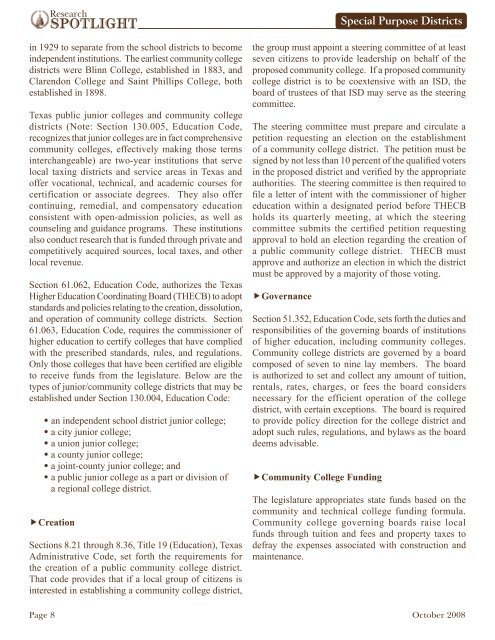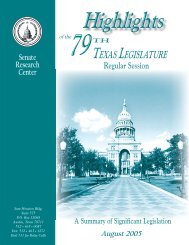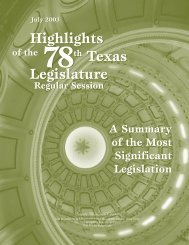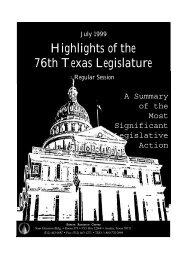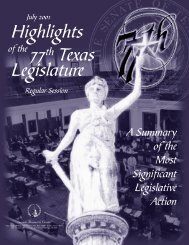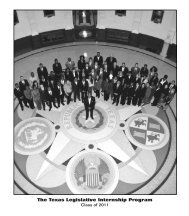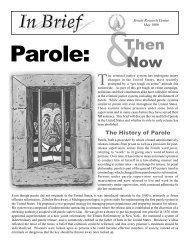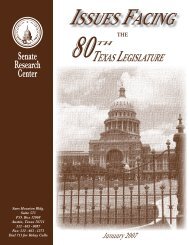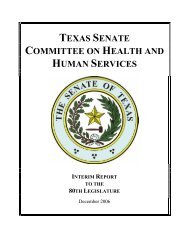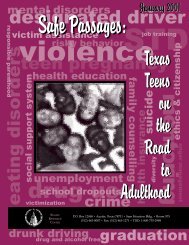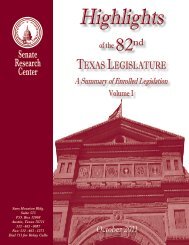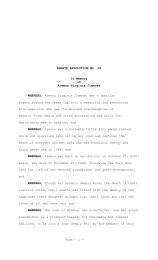Invisible Government: Special Purpose Districts in Texas - Senate
Invisible Government: Special Purpose Districts in Texas - Senate
Invisible Government: Special Purpose Districts in Texas - Senate
Create successful ePaper yourself
Turn your PDF publications into a flip-book with our unique Google optimized e-Paper software.
Research<br />
SPOTLIGHT<br />
<strong>in</strong> 1929 to separate from the school districts to become<br />
<strong>in</strong>dependent <strong>in</strong>stitutions. The earliest community college<br />
districts were Bl<strong>in</strong>n College, established <strong>in</strong> 1883, and<br />
Clarendon College and Sa<strong>in</strong>t Phillips College, both<br />
established <strong>in</strong> 1898.<br />
<strong>Texas</strong> public junior colleges and community college<br />
districts (Note: Section 130.005, Education Code,<br />
recognizes that junior colleges are <strong>in</strong> fact comprehensive<br />
community colleges, effectively mak<strong>in</strong>g those terms<br />
<strong>in</strong>terchangeable) are two-year <strong>in</strong>stitutions that serve<br />
local tax<strong>in</strong>g districts and service areas <strong>in</strong> <strong>Texas</strong> and<br />
offer vocational, technical, and academic courses for<br />
certification or associate degrees. They also offer<br />
cont<strong>in</strong>u<strong>in</strong>g, remedial, and compensatory education<br />
consistent with open-admission policies, as well as<br />
counsel<strong>in</strong>g and guidance programs. These <strong>in</strong>stitutions<br />
also conduct research that is funded through private and<br />
competitively acquired sources, local taxes, and other<br />
local revenue.<br />
Section 61.062, Education Code, authorizes the <strong>Texas</strong><br />
Higher Education Coord<strong>in</strong>at<strong>in</strong>g Board (THECB) to adopt<br />
standards and policies relat<strong>in</strong>g to the creation, dissolution,<br />
and operation of community college districts. Section<br />
61.063, Education Code, requires the commissioner of<br />
higher education to certify colleges that have complied<br />
with the prescribed standards, rules, and regulations.<br />
Only those colleges that have been certified are eligible<br />
to receive funds from the legislature. Below are the<br />
types of junior/community college districts that may be<br />
established under Section 130.004, Education Code:<br />
••an <strong>in</strong>dependent school district junior college;<br />
••a city junior college;<br />
••a union junior college;<br />
••a county junior college;<br />
••a jo<strong>in</strong>t-county junior college; and<br />
••a public junior college as a part or division of<br />
a regional college district.<br />
ffCreation<br />
Sections 8.21 through 8.36, Title 19 (Education), <strong>Texas</strong><br />
Adm<strong>in</strong>istrative Code, set forth the requirements for<br />
the creation of a public community college district.<br />
That code provides that if a local group of citizens is<br />
<strong>in</strong>terested <strong>in</strong> establish<strong>in</strong>g a community college district,<br />
<strong>Special</strong> <strong>Purpose</strong> <strong>Districts</strong><br />
the group must appo<strong>in</strong>t a steer<strong>in</strong>g committee of at least<br />
seven citizens to provide leadership on behalf of the<br />
proposed community college. If a proposed community<br />
college district is to be coextensive with an ISD, the<br />
board of trustees of that ISD may serve as the steer<strong>in</strong>g<br />
committee.<br />
The steer<strong>in</strong>g committee must prepare and circulate a<br />
petition request<strong>in</strong>g an election on the establishment<br />
of a community college district. The petition must be<br />
signed by not less than 10 percent of the qualified voters<br />
<strong>in</strong> the proposed district and verified by the appropriate<br />
authorities. The steer<strong>in</strong>g committee is then required to<br />
file a letter of <strong>in</strong>tent with the commissioner of higher<br />
education with<strong>in</strong> a designated period before THECB<br />
holds its quarterly meet<strong>in</strong>g, at which the steer<strong>in</strong>g<br />
committee submits the certified petition request<strong>in</strong>g<br />
approval to hold an election regard<strong>in</strong>g the creation of<br />
a public community college district. THECB must<br />
approve and authorize an election <strong>in</strong> which the district<br />
must be approved by a majority of those vot<strong>in</strong>g.<br />
ffGovernance<br />
Section 51.352, Education Code, sets forth the duties and<br />
responsibilities of the govern<strong>in</strong>g boards of <strong>in</strong>stitutions<br />
of higher education, <strong>in</strong>clud<strong>in</strong>g community colleges.<br />
Community college districts are governed by a board<br />
composed of seven to n<strong>in</strong>e lay members. The board<br />
is authorized to set and collect any amount of tuition,<br />
rentals, rates, charges, or fees the board considers<br />
necessary for the efficient operation of the college<br />
district, with certa<strong>in</strong> exceptions. The board is required<br />
to provide policy direction for the college district and<br />
adopt such rules, regulations, and bylaws as the board<br />
deems advisable.<br />
ffCommunity College Fund<strong>in</strong>g<br />
The legislature appropriates state funds based on the<br />
community and technical college fund<strong>in</strong>g formula.<br />
Community college govern<strong>in</strong>g boards raise local<br />
funds through tuition and fees and property taxes to<br />
defray the expenses associated with construction and<br />
ma<strong>in</strong>tenance.<br />
Page 8 October 2008


